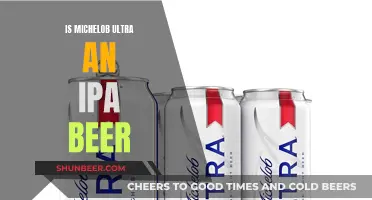
India Pale Ale (IPA) is a hoppy, fairly strong pale ale that is traditionally brewed with English malt, hops, and yeast. The American version has a slightly more pronounced malt flavour and uses American ingredients. The popularity of IPAs has led to the creation of many sub-styles, including Session IPAs, Double/Imperial IPAs, and New England-style IPAs. The defining ingredients of an IPA are hops, malt, and yeast, with hops being the most important ingredient.
IPA Beer Characteristics
| Characteristics | Values |
|---|---|
| Alcohol Content | Early IPAs were only slightly higher in alcohol content than other beers, but modern IPAs can have ABV as low as 3.6% and as high as 10% or more. |
| Bitterness | IPAs are known for their bitterness, which comes from the hops used in brewing. However, not all IPAs are bitter, and some styles, like the New England IPA, have lower bitterness. |
| Hoppiness | IPAs are hoppy beers, with some styles like the West Coast IPA being especially hop-forward. The amount of hops used can vary, and double IPAs or Imperial IPAs have a higher hop concentration. |
| Malt | Brewers use malt in IPAs, and more malt is used to balance the increased hop flavor in double or Imperial IPAs. |
| Fruitiness | Modern IPAs often explore fruity flavors that can come from hops, and some styles like the New England IPA are known for their juicy, citrusy, and floral flavors. |
| Color | IPAs can vary in color, with some being pale or light in color, while others, like the Black IPA, are much darker. |
| Carbonation | Carbonation levels can vary among IPAs. For example, New England IPAs tend to have lower carbonation, while West Coast IPAs have higher carbonation. |
| Yeast | Different types of yeast are used in IPAs, such as English ale yeast or American ale yeast. |
| Water | The type of water used can affect the character of an IPA. For example, Burton-on-Trent in the UK is known for the superb quality of its water, which was ideal for brewing IPAs. |

Hops
The IPA (India Pale Ale) is a hoppy beer style within the broader category of pale ale. The IPA was invented in Britain and was originally an export beer shipped to India. Early IPAs were slightly higher in alcohol than other beers, and more heavily hopped.
Over time, the IPA category has splintered into a dozen sub-styles, with different colours, strengths, and yeast strains. However, the use of hops remains a defining characteristic of the style.
- Bitterness: Hops are most commonly associated with bitterness in beer. The "alpha" acids in hops provide a bitter taste that balances the sweetness of the malt. The level of bitterness in a beer can be measured by International Bittering Units (IBU).
- Flavour: In addition to bitterness, hops can also contribute a range of flavours to IPAs, such as citrus, tropical fruit, floral, and herbal notes. Different varieties of hops will impart different flavour profiles.
- Aroma: Hops are also responsible for the aroma of IPAs. The intense aromatics of certain hop varieties can enhance the fragrance of the beer.
- Dry hopping: This technique involves steeping hops in fermenting beer instead of adding them during the boil. Dry hopping creates a strong aroma and amplifies the fruity, piney, or candy-sweet notes of the hops without adding bitterness.
- Fresh hopping: Fresh hopping, or wet hopping, involves using freshly picked hops that haven't been dried. This technique can add a unique, brilliant fresh flavour to IPAs.
When it comes to hops in IPAs, there are a few key varieties that are worth mentioning:
- Cascade: This is often considered the "OG" of modern hop varieties. Developed in the Pacific Northwest, Cascade hops provide aggressive notes of pine and grapefruit. They are commonly used in West Coast IPAs.
- Centennial: A descendant of Cascade hops, Centennial hops offer similar grapefruit, pine, and floral characteristics but with higher alpha acids and oil content, resulting in a more intense flavour and aroma.
- Simcoe: Simcoe hops are known for their high oil content and tropical fruitiness, with notes of mango, pineapple, guava, and passion fruit. They are commonly used in West Coast IPAs and other hop-forward styles.
- Citra: Citra hops are light and sweet, with primary notes of lemon and grass and subtle hints of lime and melon. They are highly sought-after by brewers and are often used exclusively in popular IPAs.
- Chinook: Chinook hops have a distinct pine-heavy flavour with a touch of light spiciness. They have a high alpha acid content, which contributes to the smooth bitterness in IPAs.
The use of hops in IPAs continues to evolve, with brewers experimenting with new varieties, techniques, and combinations to create unique and distinctive flavours.
Guinness Beer: A Unique Irish Dry Stout Experience
You may want to see also

Malt
Historically, IPAs were brewed with coke-fired malt, which produced less smoke and roasting of barley during the malting process, resulting in a paler beer. Today, there are many different types of malt that can be used in IPA brewing, each contributing its own unique characteristics to the final product.
For example, when brewing a West Coast IPA, a popular choice for the base malt is Golden Promise. This malt is known for bringing exceptional balance to beer styles with strong hops flavours, like a West Coast IPA. It leaves behind a bit more malt character, adding complexity to the IPA. Other base malts that can be used for West Coast IPAs include Best Pale Ale and Extra Pale Ale.
In addition to the base malt, crystal malt is also commonly used in IPAs. Crystal malt adds sweetness and maltiness to the beer. For West Coast IPAs, a small amount of Premium English Caramalt is typically used to balance out the bitterness from the hops. Other options include Caramalt and Crystal Light, but these should also be used sparingly.
When brewing an East Coast IPA, brewers often use more caramel malt to provide contrast to the hop bitterness. This results in a beer with a fuller body and a slightly different flavour profile compared to a West Coast IPA.
For New England IPAs (NEIPAs), the choice of malt is also important. While NEIPAs are known for their hazy appearance, the use of certain malts can enhance this characteristic. Higher-protein grains like wheat and oats are often used in NEIPAs, contributing to the haze while also providing a smoother mouthfeel.
Overall, the choice of malt is crucial in IPA brewing as it affects the colour, flavour, body, and haze of the final product. Brewers can experiment with different types of malt to achieve their desired flavour profile and create a well-balanced IPA.
What Defines an IPA Beer?
You may want to see also

Yeast
Ale yeast, also known as top-fermenting yeast, rises to the top of the fermenter during fermentation. It creates a thick yeast head at the top of the carboy in the early stages of fermentation. Ale yeasts typically ferment at temperatures between 10°C and 25°C, with an ideal range of 18°C to 22°C. This makes them convenient for home brewers, as these temperatures are relatively easy to maintain. Ale yeast is commonly used for brewing ales, stouts, porters, wheat beers, Altbier, and Kölsch.
On the other hand, lager yeast is a bottom-fermenting yeast that works at colder temperatures, usually between 7°C and 15°C. Lager yeasts don't reproduce as quickly as ale yeasts, and they tend to settle at the bottom of the fermenter. The colder fermentation temperatures inhibit the production of certain chemical by-products, resulting in a "cleaner" taste associated with lagers. Lager yeast is typically used for brewing Lagers, Pilsners, Bocks, Märzen, and Dortmunders.
When it comes to IPAs, yeast plays a crucial role in defining the style of the beer. The choice of yeast strain can make a significant difference in the final product, especially in the case of NEIPAs (New England IPAs) and Hazy IPAs. NEIPA strains are characterised by a process called "biotransformation," where the yeast interacts with the aromatic oils in the hops, creating new aromatic compounds and amplifying the tropical fruit flavours.
There are several popular yeast strains used for brewing NEIPAs and Hazy IPAs. One of the most widely used strains is Wyeast 1318 London III, known for its biotransformation ability and ester-hop balance. Other popular options include GigaYeast GY054 Vermont IPA, which provides a slightly fuller body and lets the fruity hop varieties stand out; and White Labs WLP066 London Fog, renowned for its biotransformation abilities and rich ester profile.
When selecting a yeast strain for an IPA, it's important to consider factors such as attenuation, flocculation, optimal fermentation temperature, and the flavour profile it will contribute to the beer. Attenuation refers to the degree to which the yeast ferments the sugars in the wort, while flocculation refers to the clumping of yeast cells, which affects the clarity of the beer. Optimal fermentation temperature is crucial, as brewing outside the yeast's preferred temperature range can lead to slow fermentation or the production of off-flavours.
In addition to the choice of yeast strain, other factors that impact the character of an IPA include the type of hops used, the timing of hop additions, water chemistry, and brewing techniques. However, yeast remains a key component in defining the style, flavour, and overall quality of an IPA.
Guinness Beer's Dark Mystery: A Stout Conundrum
You may want to see also

Water
The pH of the water used for IPAs should be slightly acidic, with a pH of 5.2 to 5.4. This is slightly lower than some other beer styles. The pH can be altered by adding Epsom salts, gypsum, and baking soda.
The mineral content of the water is also important. There are five primary ions in water that positively affect the flavour of your beer: calcium, chloride, magnesium, sodium, and sulphate. The mineral content can be adjusted by adding mineral supplements, such as tablets, powders, or liquid tinctures.
The type of water used can also impact the flavour of the beer. Clean surface waters from lakes, rivers, and streams tend to have fewer minerals, providing a blank slate to which desired minerals can be added. Groundwater or well water, on the other hand, has more dissolved minerals, which will impact the flavour of the beer.
Guinness Beer: Dairy-Free Delight or Dairy Disaster?
You may want to see also

Fruit
- Passion fruit
- Apricot
- Tangerine
- Pineapple
- Mango
- Lime
- Melon
- Grapefruit
- Blood orange
- Guava
- Peach
- Blackberry
- Raspberry
- Cherry
- Blackberry
- Strawberry
- Blueberry
- Apricot
- Pear
- Watermelon
- Stone fruit
- Lemon
The most popular fruit IPAs use fruits that either accentuate the citrus character of their hops (like grapefruit or blood orange IPAs) or the tropical character of their hops (like mango or pineapple IPAs). The best fruit IPAs have enough fruit character that you can tell it's not an ordinary IPA, but not so much that the underlying beer is totally obscured.
Guinness Beer Alternatives: Exploring Dark Beer Options
You may want to see also
Frequently asked questions
The main ingredients in an IPA are hops, malt, and yeast.
Hops are a natural preservative that gives IPAs their bitter taste.
Some craft brewers experiment with unusual ingredients in their IPAs, such as squid ink, cactus nectar, and gin-barrel aging.







